Business Process Management Article Review for BCO5501 Course
VerifiedAdded on 2023/03/17
|10
|3016
|64
Report
AI Summary
This report provides a comprehensive review of the article "Monitoring Business Meta constraints Based on LTL and LDL for Finite Traces" by De Giacomo et al. (2014). The article explores the importance of runtime monitoring in business process management, focusing on how to monitor business metaconstraints using Linear Temporal Logic (LTL) and Linear Dynamic Logic (LDL) for finite traces. The review discusses the article's intention, which is to provide effective techniques for runtime monitoring to support operational decision-making and ensure compliance with rules and constraints. The research method involved adopting LTL and LDL on finite runs and proposing Linear Dynamic Logic of Finite Traces (LDLf) to overcome challenges. The report highlights the authors' findings, including the automation of LDLf and its application in runtime monitoring. The review also addresses the problems highlighted by the authors, such as the lack of comprehensive techniques for runtime verification and the need for advanced monitoring of constraints. The report then assesses the article's relevance to business process management, emphasizing its approach to monitoring dynamic constraints over finite traces. Finally, the review compares the ideas presented in the article with other relevant research, such as articles by Debois, Hildebrandt and Slaats (2014) and Di Ciccio, Maggi and Mendling (2014), to provide a broader understanding of the concepts. The assignment fulfills the requirements of a review essay, including a title page, discussion, and conclusion, supported by citations in the Harvard style.

Running head: BUSINESS PROCESS MANAGEMENT
Business Process Management in Industry: Monitoring Business Metaconstraints Based
on LTL and LDL for Finite Traces
Name of the Student
Name of the University
Author’s Note:
Business Process Management in Industry: Monitoring Business Metaconstraints Based
on LTL and LDL for Finite Traces
Name of the Student
Name of the University
Author’s Note:
Paraphrase This Document
Need a fresh take? Get an instant paraphrase of this document with our AI Paraphraser
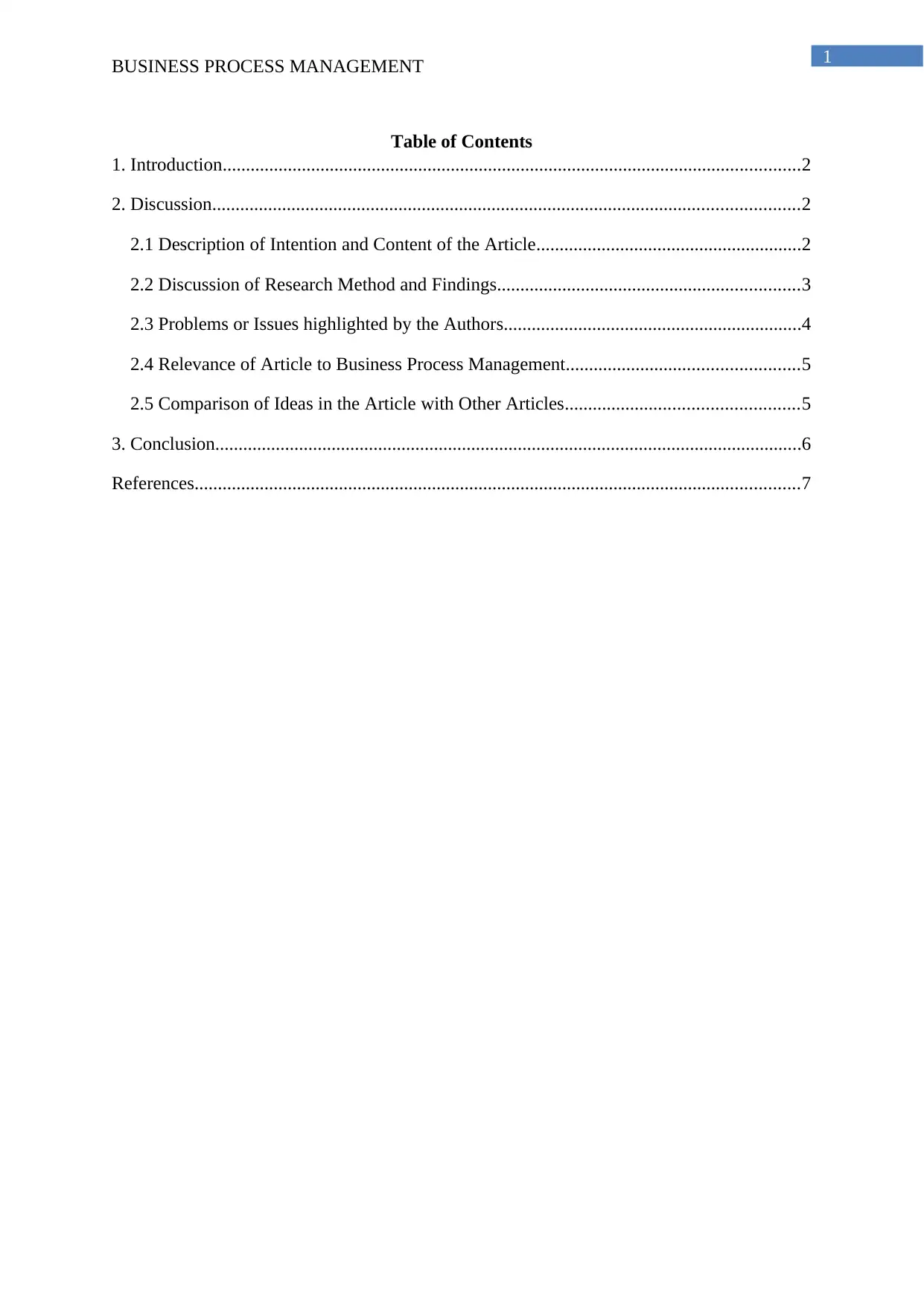
1
BUSINESS PROCESS MANAGEMENT
Table of Contents
1. Introduction............................................................................................................................2
2. Discussion..............................................................................................................................2
2.1 Description of Intention and Content of the Article.........................................................2
2.2 Discussion of Research Method and Findings.................................................................3
2.3 Problems or Issues highlighted by the Authors................................................................4
2.4 Relevance of Article to Business Process Management..................................................5
2.5 Comparison of Ideas in the Article with Other Articles..................................................5
3. Conclusion..............................................................................................................................6
References..................................................................................................................................7
BUSINESS PROCESS MANAGEMENT
Table of Contents
1. Introduction............................................................................................................................2
2. Discussion..............................................................................................................................2
2.1 Description of Intention and Content of the Article.........................................................2
2.2 Discussion of Research Method and Findings.................................................................3
2.3 Problems or Issues highlighted by the Authors................................................................4
2.4 Relevance of Article to Business Process Management..................................................5
2.5 Comparison of Ideas in the Article with Other Articles..................................................5
3. Conclusion..............................................................................................................................6
References..................................................................................................................................7
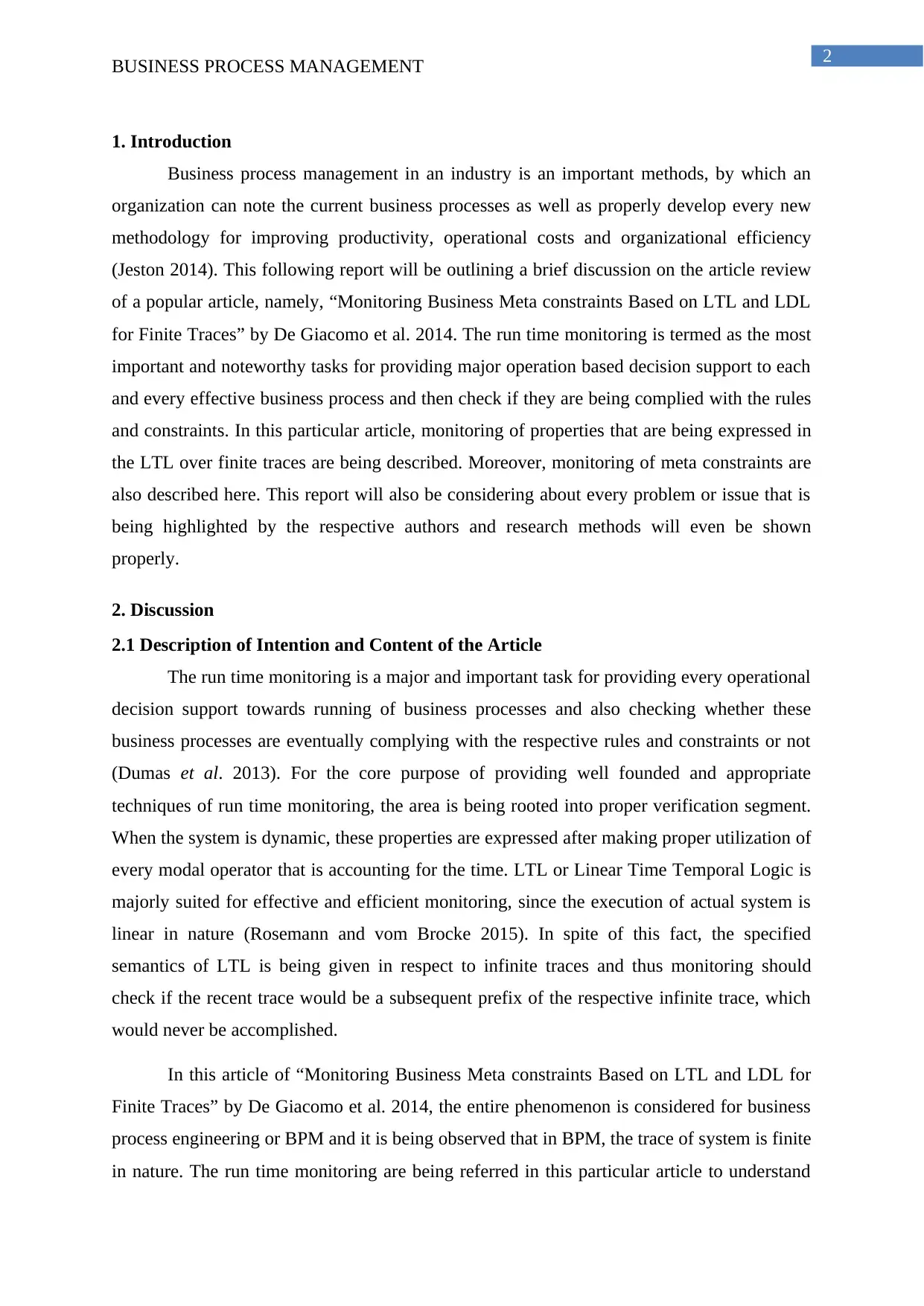
2
BUSINESS PROCESS MANAGEMENT
1. Introduction
Business process management in an industry is an important methods, by which an
organization can note the current business processes as well as properly develop every new
methodology for improving productivity, operational costs and organizational efficiency
(Jeston 2014). This following report will be outlining a brief discussion on the article review
of a popular article, namely, “Monitoring Business Meta constraints Based on LTL and LDL
for Finite Traces” by De Giacomo et al. 2014. The run time monitoring is termed as the most
important and noteworthy tasks for providing major operation based decision support to each
and every effective business process and then check if they are being complied with the rules
and constraints. In this particular article, monitoring of properties that are being expressed in
the LTL over finite traces are being described. Moreover, monitoring of meta constraints are
also described here. This report will also be considering about every problem or issue that is
being highlighted by the respective authors and research methods will even be shown
properly.
2. Discussion
2.1 Description of Intention and Content of the Article
The run time monitoring is a major and important task for providing every operational
decision support towards running of business processes and also checking whether these
business processes are eventually complying with the respective rules and constraints or not
(Dumas et al. 2013). For the core purpose of providing well founded and appropriate
techniques of run time monitoring, the area is being rooted into proper verification segment.
When the system is dynamic, these properties are expressed after making proper utilization of
every modal operator that is accounting for the time. LTL or Linear Time Temporal Logic is
majorly suited for effective and efficient monitoring, since the execution of actual system is
linear in nature (Rosemann and vom Brocke 2015). In spite of this fact, the specified
semantics of LTL is being given in respect to infinite traces and thus monitoring should
check if the recent trace would be a subsequent prefix of the respective infinite trace, which
would never be accomplished.
In this article of “Monitoring Business Meta constraints Based on LTL and LDL for
Finite Traces” by De Giacomo et al. 2014, the entire phenomenon is considered for business
process engineering or BPM and it is being observed that in BPM, the trace of system is finite
in nature. The run time monitoring are being referred in this particular article to understand
BUSINESS PROCESS MANAGEMENT
1. Introduction
Business process management in an industry is an important methods, by which an
organization can note the current business processes as well as properly develop every new
methodology for improving productivity, operational costs and organizational efficiency
(Jeston 2014). This following report will be outlining a brief discussion on the article review
of a popular article, namely, “Monitoring Business Meta constraints Based on LTL and LDL
for Finite Traces” by De Giacomo et al. 2014. The run time monitoring is termed as the most
important and noteworthy tasks for providing major operation based decision support to each
and every effective business process and then check if they are being complied with the rules
and constraints. In this particular article, monitoring of properties that are being expressed in
the LTL over finite traces are being described. Moreover, monitoring of meta constraints are
also described here. This report will also be considering about every problem or issue that is
being highlighted by the respective authors and research methods will even be shown
properly.
2. Discussion
2.1 Description of Intention and Content of the Article
The run time monitoring is a major and important task for providing every operational
decision support towards running of business processes and also checking whether these
business processes are eventually complying with the respective rules and constraints or not
(Dumas et al. 2013). For the core purpose of providing well founded and appropriate
techniques of run time monitoring, the area is being rooted into proper verification segment.
When the system is dynamic, these properties are expressed after making proper utilization of
every modal operator that is accounting for the time. LTL or Linear Time Temporal Logic is
majorly suited for effective and efficient monitoring, since the execution of actual system is
linear in nature (Rosemann and vom Brocke 2015). In spite of this fact, the specified
semantics of LTL is being given in respect to infinite traces and thus monitoring should
check if the recent trace would be a subsequent prefix of the respective infinite trace, which
would never be accomplished.
In this article of “Monitoring Business Meta constraints Based on LTL and LDL for
Finite Traces” by De Giacomo et al. 2014, the entire phenomenon is considered for business
process engineering or BPM and it is being observed that in BPM, the trace of system is finite
in nature. The run time monitoring are being referred in this particular article to understand
⊘ This is a preview!⊘
Do you want full access?
Subscribe today to unlock all pages.

Trusted by 1+ million students worldwide
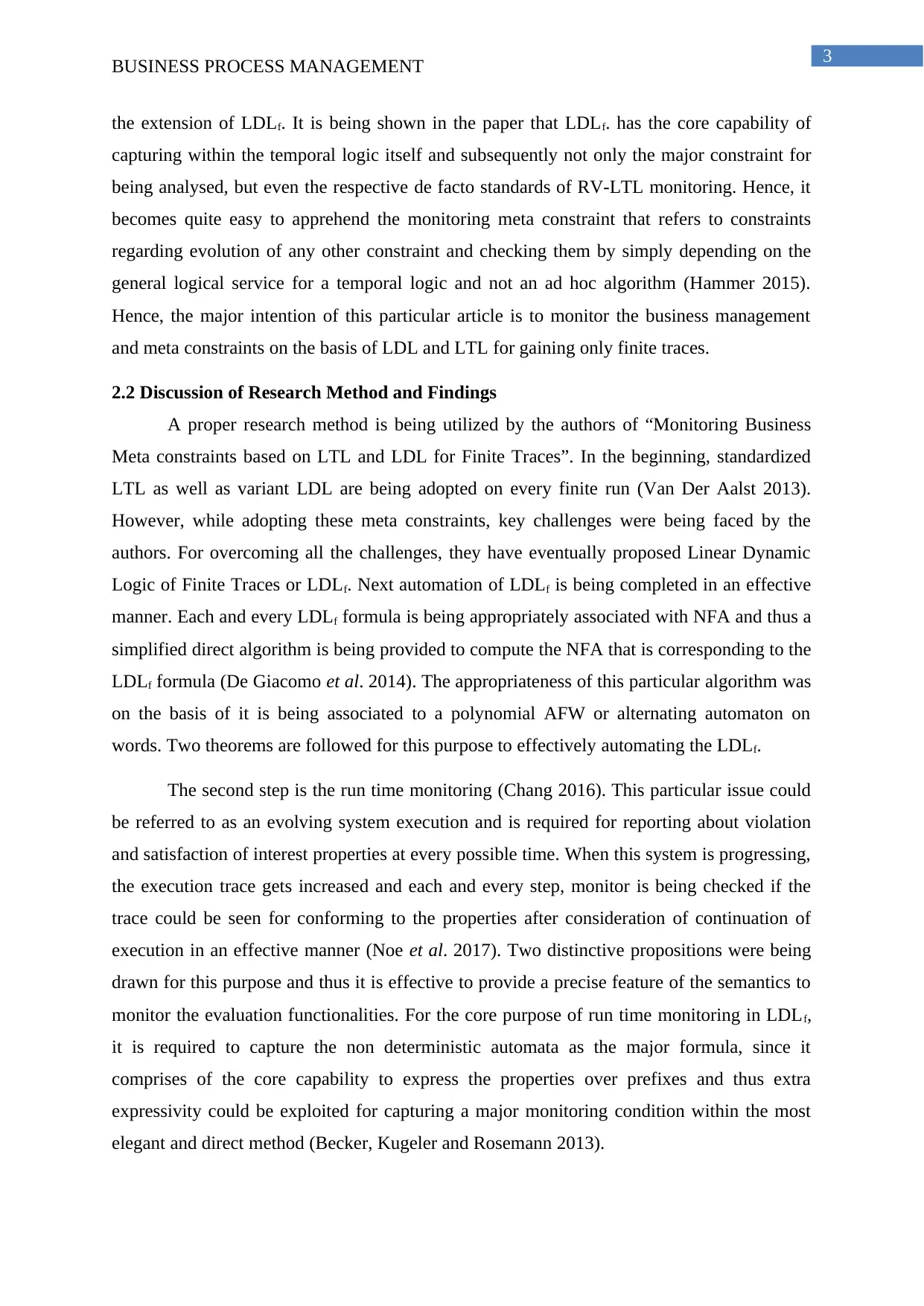
3
BUSINESS PROCESS MANAGEMENT
the extension of LDLf. It is being shown in the paper that LDLf. has the core capability of
capturing within the temporal logic itself and subsequently not only the major constraint for
being analysed, but even the respective de facto standards of RV-LTL monitoring. Hence, it
becomes quite easy to apprehend the monitoring meta constraint that refers to constraints
regarding evolution of any other constraint and checking them by simply depending on the
general logical service for a temporal logic and not an ad hoc algorithm (Hammer 2015).
Hence, the major intention of this particular article is to monitor the business management
and meta constraints on the basis of LDL and LTL for gaining only finite traces.
2.2 Discussion of Research Method and Findings
A proper research method is being utilized by the authors of “Monitoring Business
Meta constraints based on LTL and LDL for Finite Traces”. In the beginning, standardized
LTL as well as variant LDL are being adopted on every finite run (Van Der Aalst 2013).
However, while adopting these meta constraints, key challenges were being faced by the
authors. For overcoming all the challenges, they have eventually proposed Linear Dynamic
Logic of Finite Traces or LDLf. Next automation of LDLf is being completed in an effective
manner. Each and every LDLf formula is being appropriately associated with NFA and thus a
simplified direct algorithm is being provided to compute the NFA that is corresponding to the
LDLf formula (De Giacomo et al. 2014). The appropriateness of this particular algorithm was
on the basis of it is being associated to a polynomial AFW or alternating automaton on
words. Two theorems are followed for this purpose to effectively automating the LDLf.
The second step is the run time monitoring (Chang 2016). This particular issue could
be referred to as an evolving system execution and is required for reporting about violation
and satisfaction of interest properties at every possible time. When this system is progressing,
the execution trace gets increased and each and every step, monitor is being checked if the
trace could be seen for conforming to the properties after consideration of continuation of
execution in an effective manner (Noe et al. 2017). Two distinctive propositions were being
drawn for this purpose and thus it is effective to provide a precise feature of the semantics to
monitor the evaluation functionalities. For the core purpose of run time monitoring in LDLf,
it is required to capture the non deterministic automata as the major formula, since it
comprises of the core capability to express the properties over prefixes and thus extra
expressivity could be exploited for capturing a major monitoring condition within the most
elegant and direct method (Becker, Kugeler and Rosemann 2013).
BUSINESS PROCESS MANAGEMENT
the extension of LDLf. It is being shown in the paper that LDLf. has the core capability of
capturing within the temporal logic itself and subsequently not only the major constraint for
being analysed, but even the respective de facto standards of RV-LTL monitoring. Hence, it
becomes quite easy to apprehend the monitoring meta constraint that refers to constraints
regarding evolution of any other constraint and checking them by simply depending on the
general logical service for a temporal logic and not an ad hoc algorithm (Hammer 2015).
Hence, the major intention of this particular article is to monitor the business management
and meta constraints on the basis of LDL and LTL for gaining only finite traces.
2.2 Discussion of Research Method and Findings
A proper research method is being utilized by the authors of “Monitoring Business
Meta constraints based on LTL and LDL for Finite Traces”. In the beginning, standardized
LTL as well as variant LDL are being adopted on every finite run (Van Der Aalst 2013).
However, while adopting these meta constraints, key challenges were being faced by the
authors. For overcoming all the challenges, they have eventually proposed Linear Dynamic
Logic of Finite Traces or LDLf. Next automation of LDLf is being completed in an effective
manner. Each and every LDLf formula is being appropriately associated with NFA and thus a
simplified direct algorithm is being provided to compute the NFA that is corresponding to the
LDLf formula (De Giacomo et al. 2014). The appropriateness of this particular algorithm was
on the basis of it is being associated to a polynomial AFW or alternating automaton on
words. Two theorems are followed for this purpose to effectively automating the LDLf.
The second step is the run time monitoring (Chang 2016). This particular issue could
be referred to as an evolving system execution and is required for reporting about violation
and satisfaction of interest properties at every possible time. When this system is progressing,
the execution trace gets increased and each and every step, monitor is being checked if the
trace could be seen for conforming to the properties after consideration of continuation of
execution in an effective manner (Noe et al. 2017). Two distinctive propositions were being
drawn for this purpose and thus it is effective to provide a precise feature of the semantics to
monitor the evaluation functionalities. For the core purpose of run time monitoring in LDLf,
it is required to capture the non deterministic automata as the major formula, since it
comprises of the core capability to express the properties over prefixes and thus extra
expressivity could be exploited for capturing a major monitoring condition within the most
elegant and direct method (Becker, Kugeler and Rosemann 2013).
Paraphrase This Document
Need a fresh take? Get an instant paraphrase of this document with our AI Paraphraser
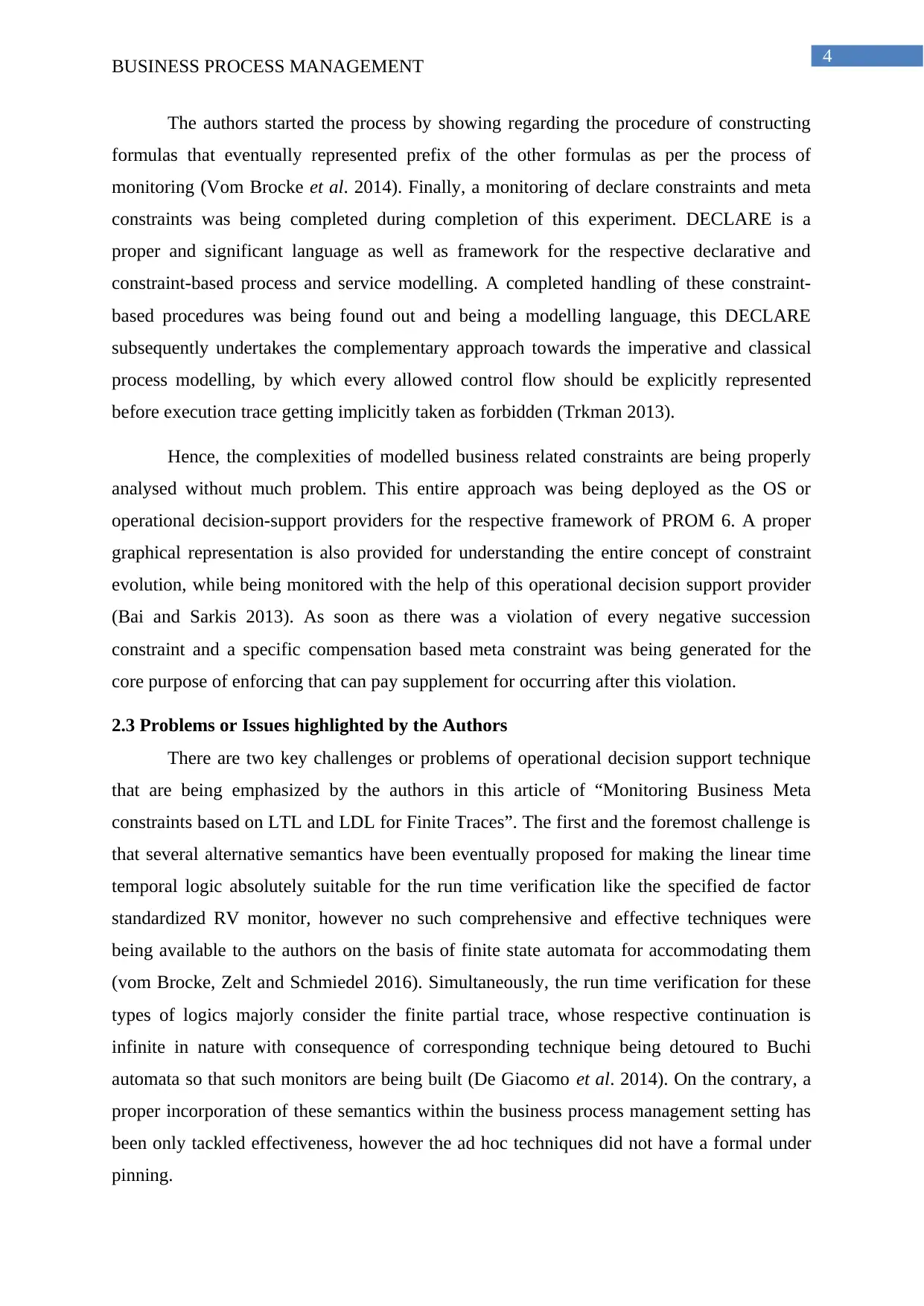
4
BUSINESS PROCESS MANAGEMENT
The authors started the process by showing regarding the procedure of constructing
formulas that eventually represented prefix of the other formulas as per the process of
monitoring (Vom Brocke et al. 2014). Finally, a monitoring of declare constraints and meta
constraints was being completed during completion of this experiment. DECLARE is a
proper and significant language as well as framework for the respective declarative and
constraint-based process and service modelling. A completed handling of these constraint-
based procedures was being found out and being a modelling language, this DECLARE
subsequently undertakes the complementary approach towards the imperative and classical
process modelling, by which every allowed control flow should be explicitly represented
before execution trace getting implicitly taken as forbidden (Trkman 2013).
Hence, the complexities of modelled business related constraints are being properly
analysed without much problem. This entire approach was being deployed as the OS or
operational decision-support providers for the respective framework of PROM 6. A proper
graphical representation is also provided for understanding the entire concept of constraint
evolution, while being monitored with the help of this operational decision support provider
(Bai and Sarkis 2013). As soon as there was a violation of every negative succession
constraint and a specific compensation based meta constraint was being generated for the
core purpose of enforcing that can pay supplement for occurring after this violation.
2.3 Problems or Issues highlighted by the Authors
There are two key challenges or problems of operational decision support technique
that are being emphasized by the authors in this article of “Monitoring Business Meta
constraints based on LTL and LDL for Finite Traces”. The first and the foremost challenge is
that several alternative semantics have been eventually proposed for making the linear time
temporal logic absolutely suitable for the run time verification like the specified de factor
standardized RV monitor, however no such comprehensive and effective techniques were
being available to the authors on the basis of finite state automata for accommodating them
(vom Brocke, Zelt and Schmiedel 2016). Simultaneously, the run time verification for these
types of logics majorly consider the finite partial trace, whose respective continuation is
infinite in nature with consequence of corresponding technique being detoured to Buchi
automata so that such monitors are being built (De Giacomo et al. 2014). On the contrary, a
proper incorporation of these semantics within the business process management setting has
been only tackled effectiveness, however the ad hoc techniques did not have a formal under
pinning.
BUSINESS PROCESS MANAGEMENT
The authors started the process by showing regarding the procedure of constructing
formulas that eventually represented prefix of the other formulas as per the process of
monitoring (Vom Brocke et al. 2014). Finally, a monitoring of declare constraints and meta
constraints was being completed during completion of this experiment. DECLARE is a
proper and significant language as well as framework for the respective declarative and
constraint-based process and service modelling. A completed handling of these constraint-
based procedures was being found out and being a modelling language, this DECLARE
subsequently undertakes the complementary approach towards the imperative and classical
process modelling, by which every allowed control flow should be explicitly represented
before execution trace getting implicitly taken as forbidden (Trkman 2013).
Hence, the complexities of modelled business related constraints are being properly
analysed without much problem. This entire approach was being deployed as the OS or
operational decision-support providers for the respective framework of PROM 6. A proper
graphical representation is also provided for understanding the entire concept of constraint
evolution, while being monitored with the help of this operational decision support provider
(Bai and Sarkis 2013). As soon as there was a violation of every negative succession
constraint and a specific compensation based meta constraint was being generated for the
core purpose of enforcing that can pay supplement for occurring after this violation.
2.3 Problems or Issues highlighted by the Authors
There are two key challenges or problems of operational decision support technique
that are being emphasized by the authors in this article of “Monitoring Business Meta
constraints based on LTL and LDL for Finite Traces”. The first and the foremost challenge is
that several alternative semantics have been eventually proposed for making the linear time
temporal logic absolutely suitable for the run time verification like the specified de factor
standardized RV monitor, however no such comprehensive and effective techniques were
being available to the authors on the basis of finite state automata for accommodating them
(vom Brocke, Zelt and Schmiedel 2016). Simultaneously, the run time verification for these
types of logics majorly consider the finite partial trace, whose respective continuation is
infinite in nature with consequence of corresponding technique being detoured to Buchi
automata so that such monitors are being built (De Giacomo et al. 2014). On the contrary, a
proper incorporation of these semantics within the business process management setting has
been only tackled effectiveness, however the ad hoc techniques did not have a formal under
pinning.
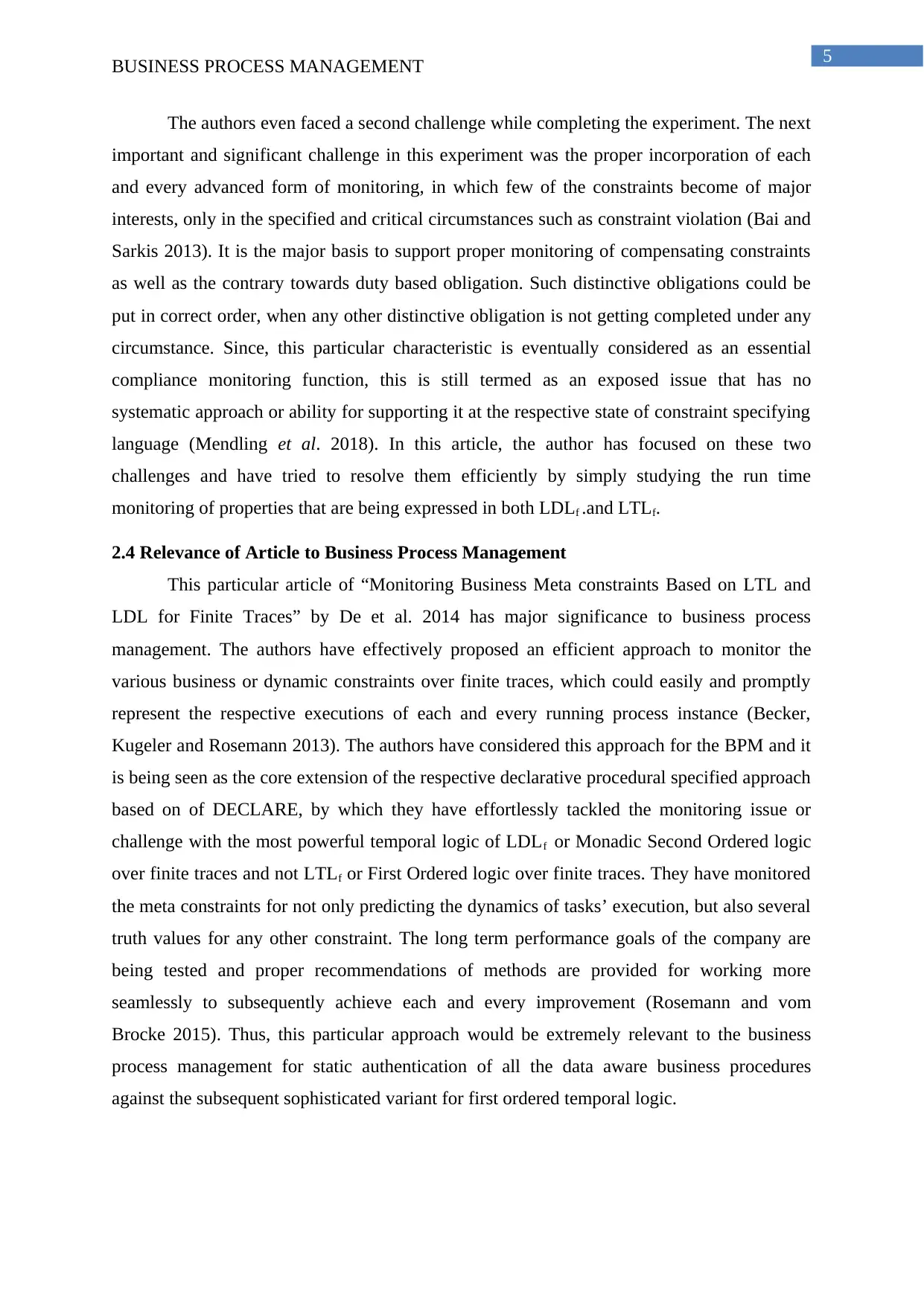
5
BUSINESS PROCESS MANAGEMENT
The authors even faced a second challenge while completing the experiment. The next
important and significant challenge in this experiment was the proper incorporation of each
and every advanced form of monitoring, in which few of the constraints become of major
interests, only in the specified and critical circumstances such as constraint violation (Bai and
Sarkis 2013). It is the major basis to support proper monitoring of compensating constraints
as well as the contrary towards duty based obligation. Such distinctive obligations could be
put in correct order, when any other distinctive obligation is not getting completed under any
circumstance. Since, this particular characteristic is eventually considered as an essential
compliance monitoring function, this is still termed as an exposed issue that has no
systematic approach or ability for supporting it at the respective state of constraint specifying
language (Mendling et al. 2018). In this article, the author has focused on these two
challenges and have tried to resolve them efficiently by simply studying the run time
monitoring of properties that are being expressed in both LDLf .and LTLf.
2.4 Relevance of Article to Business Process Management
This particular article of “Monitoring Business Meta constraints Based on LTL and
LDL for Finite Traces” by De et al. 2014 has major significance to business process
management. The authors have effectively proposed an efficient approach to monitor the
various business or dynamic constraints over finite traces, which could easily and promptly
represent the respective executions of each and every running process instance (Becker,
Kugeler and Rosemann 2013). The authors have considered this approach for the BPM and it
is being seen as the core extension of the respective declarative procedural specified approach
based on of DECLARE, by which they have effortlessly tackled the monitoring issue or
challenge with the most powerful temporal logic of LDLf or Monadic Second Ordered logic
over finite traces and not LTLf or First Ordered logic over finite traces. They have monitored
the meta constraints for not only predicting the dynamics of tasks’ execution, but also several
truth values for any other constraint. The long term performance goals of the company are
being tested and proper recommendations of methods are provided for working more
seamlessly to subsequently achieve each and every improvement (Rosemann and vom
Brocke 2015). Thus, this particular approach would be extremely relevant to the business
process management for static authentication of all the data aware business procedures
against the subsequent sophisticated variant for first ordered temporal logic.
BUSINESS PROCESS MANAGEMENT
The authors even faced a second challenge while completing the experiment. The next
important and significant challenge in this experiment was the proper incorporation of each
and every advanced form of monitoring, in which few of the constraints become of major
interests, only in the specified and critical circumstances such as constraint violation (Bai and
Sarkis 2013). It is the major basis to support proper monitoring of compensating constraints
as well as the contrary towards duty based obligation. Such distinctive obligations could be
put in correct order, when any other distinctive obligation is not getting completed under any
circumstance. Since, this particular characteristic is eventually considered as an essential
compliance monitoring function, this is still termed as an exposed issue that has no
systematic approach or ability for supporting it at the respective state of constraint specifying
language (Mendling et al. 2018). In this article, the author has focused on these two
challenges and have tried to resolve them efficiently by simply studying the run time
monitoring of properties that are being expressed in both LDLf .and LTLf.
2.4 Relevance of Article to Business Process Management
This particular article of “Monitoring Business Meta constraints Based on LTL and
LDL for Finite Traces” by De et al. 2014 has major significance to business process
management. The authors have effectively proposed an efficient approach to monitor the
various business or dynamic constraints over finite traces, which could easily and promptly
represent the respective executions of each and every running process instance (Becker,
Kugeler and Rosemann 2013). The authors have considered this approach for the BPM and it
is being seen as the core extension of the respective declarative procedural specified approach
based on of DECLARE, by which they have effortlessly tackled the monitoring issue or
challenge with the most powerful temporal logic of LDLf or Monadic Second Ordered logic
over finite traces and not LTLf or First Ordered logic over finite traces. They have monitored
the meta constraints for not only predicting the dynamics of tasks’ execution, but also several
truth values for any other constraint. The long term performance goals of the company are
being tested and proper recommendations of methods are provided for working more
seamlessly to subsequently achieve each and every improvement (Rosemann and vom
Brocke 2015). Thus, this particular approach would be extremely relevant to the business
process management for static authentication of all the data aware business procedures
against the subsequent sophisticated variant for first ordered temporal logic.
⊘ This is a preview!⊘
Do you want full access?
Subscribe today to unlock all pages.

Trusted by 1+ million students worldwide
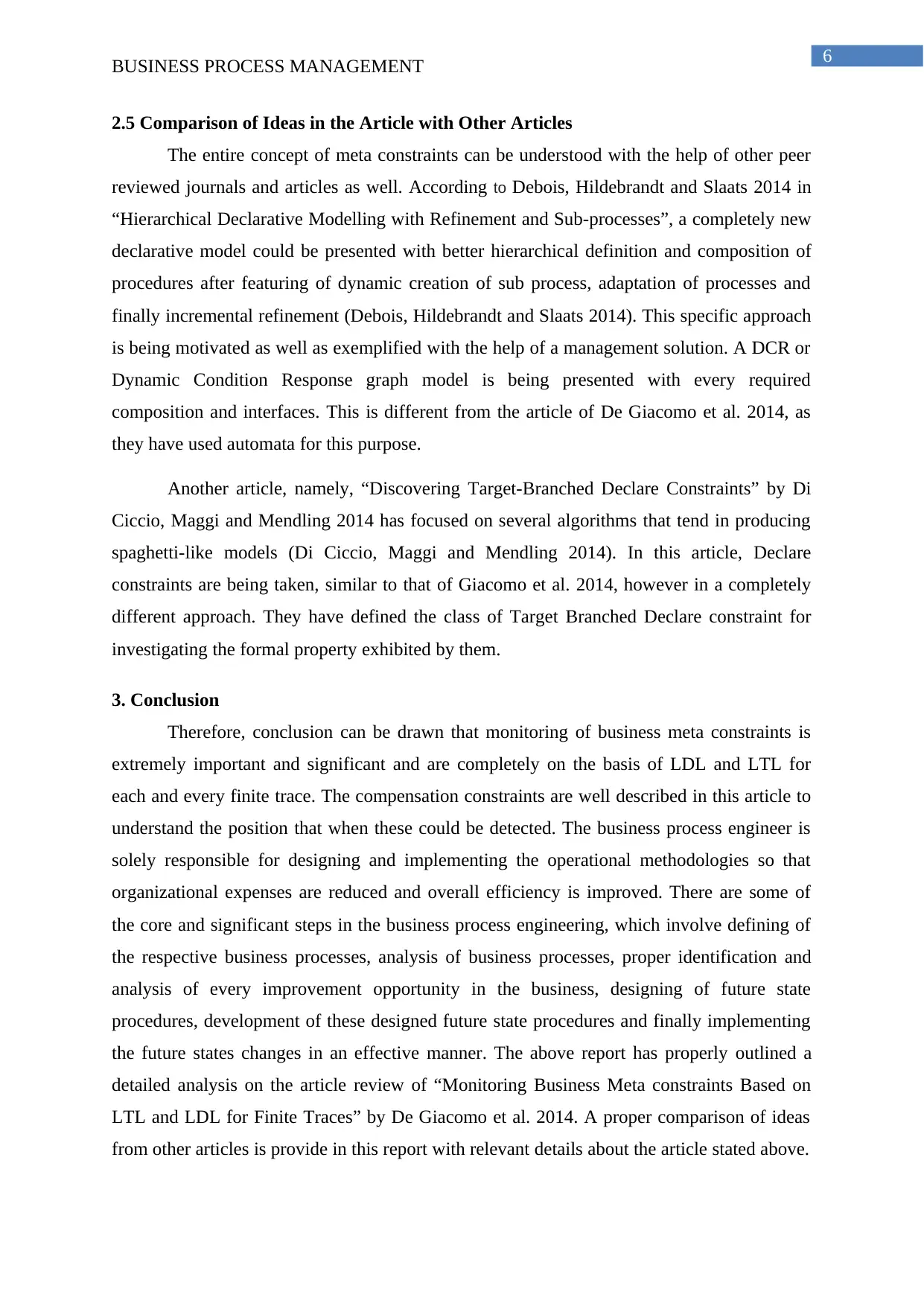
6
BUSINESS PROCESS MANAGEMENT
2.5 Comparison of Ideas in the Article with Other Articles
The entire concept of meta constraints can be understood with the help of other peer
reviewed journals and articles as well. According to Debois, Hildebrandt and Slaats 2014 in
“Hierarchical Declarative Modelling with Refinement and Sub-processes”, a completely new
declarative model could be presented with better hierarchical definition and composition of
procedures after featuring of dynamic creation of sub process, adaptation of processes and
finally incremental refinement (Debois, Hildebrandt and Slaats 2014). This specific approach
is being motivated as well as exemplified with the help of a management solution. A DCR or
Dynamic Condition Response graph model is being presented with every required
composition and interfaces. This is different from the article of De Giacomo et al. 2014, as
they have used automata for this purpose.
Another article, namely, “Discovering Target-Branched Declare Constraints” by Di
Ciccio, Maggi and Mendling 2014 has focused on several algorithms that tend in producing
spaghetti-like models (Di Ciccio, Maggi and Mendling 2014). In this article, Declare
constraints are being taken, similar to that of Giacomo et al. 2014, however in a completely
different approach. They have defined the class of Target Branched Declare constraint for
investigating the formal property exhibited by them.
3. Conclusion
Therefore, conclusion can be drawn that monitoring of business meta constraints is
extremely important and significant and are completely on the basis of LDL and LTL for
each and every finite trace. The compensation constraints are well described in this article to
understand the position that when these could be detected. The business process engineer is
solely responsible for designing and implementing the operational methodologies so that
organizational expenses are reduced and overall efficiency is improved. There are some of
the core and significant steps in the business process engineering, which involve defining of
the respective business processes, analysis of business processes, proper identification and
analysis of every improvement opportunity in the business, designing of future state
procedures, development of these designed future state procedures and finally implementing
the future states changes in an effective manner. The above report has properly outlined a
detailed analysis on the article review of “Monitoring Business Meta constraints Based on
LTL and LDL for Finite Traces” by De Giacomo et al. 2014. A proper comparison of ideas
from other articles is provide in this report with relevant details about the article stated above.
BUSINESS PROCESS MANAGEMENT
2.5 Comparison of Ideas in the Article with Other Articles
The entire concept of meta constraints can be understood with the help of other peer
reviewed journals and articles as well. According to Debois, Hildebrandt and Slaats 2014 in
“Hierarchical Declarative Modelling with Refinement and Sub-processes”, a completely new
declarative model could be presented with better hierarchical definition and composition of
procedures after featuring of dynamic creation of sub process, adaptation of processes and
finally incremental refinement (Debois, Hildebrandt and Slaats 2014). This specific approach
is being motivated as well as exemplified with the help of a management solution. A DCR or
Dynamic Condition Response graph model is being presented with every required
composition and interfaces. This is different from the article of De Giacomo et al. 2014, as
they have used automata for this purpose.
Another article, namely, “Discovering Target-Branched Declare Constraints” by Di
Ciccio, Maggi and Mendling 2014 has focused on several algorithms that tend in producing
spaghetti-like models (Di Ciccio, Maggi and Mendling 2014). In this article, Declare
constraints are being taken, similar to that of Giacomo et al. 2014, however in a completely
different approach. They have defined the class of Target Branched Declare constraint for
investigating the formal property exhibited by them.
3. Conclusion
Therefore, conclusion can be drawn that monitoring of business meta constraints is
extremely important and significant and are completely on the basis of LDL and LTL for
each and every finite trace. The compensation constraints are well described in this article to
understand the position that when these could be detected. The business process engineer is
solely responsible for designing and implementing the operational methodologies so that
organizational expenses are reduced and overall efficiency is improved. There are some of
the core and significant steps in the business process engineering, which involve defining of
the respective business processes, analysis of business processes, proper identification and
analysis of every improvement opportunity in the business, designing of future state
procedures, development of these designed future state procedures and finally implementing
the future states changes in an effective manner. The above report has properly outlined a
detailed analysis on the article review of “Monitoring Business Meta constraints Based on
LTL and LDL for Finite Traces” by De Giacomo et al. 2014. A proper comparison of ideas
from other articles is provide in this report with relevant details about the article stated above.
Paraphrase This Document
Need a fresh take? Get an instant paraphrase of this document with our AI Paraphraser
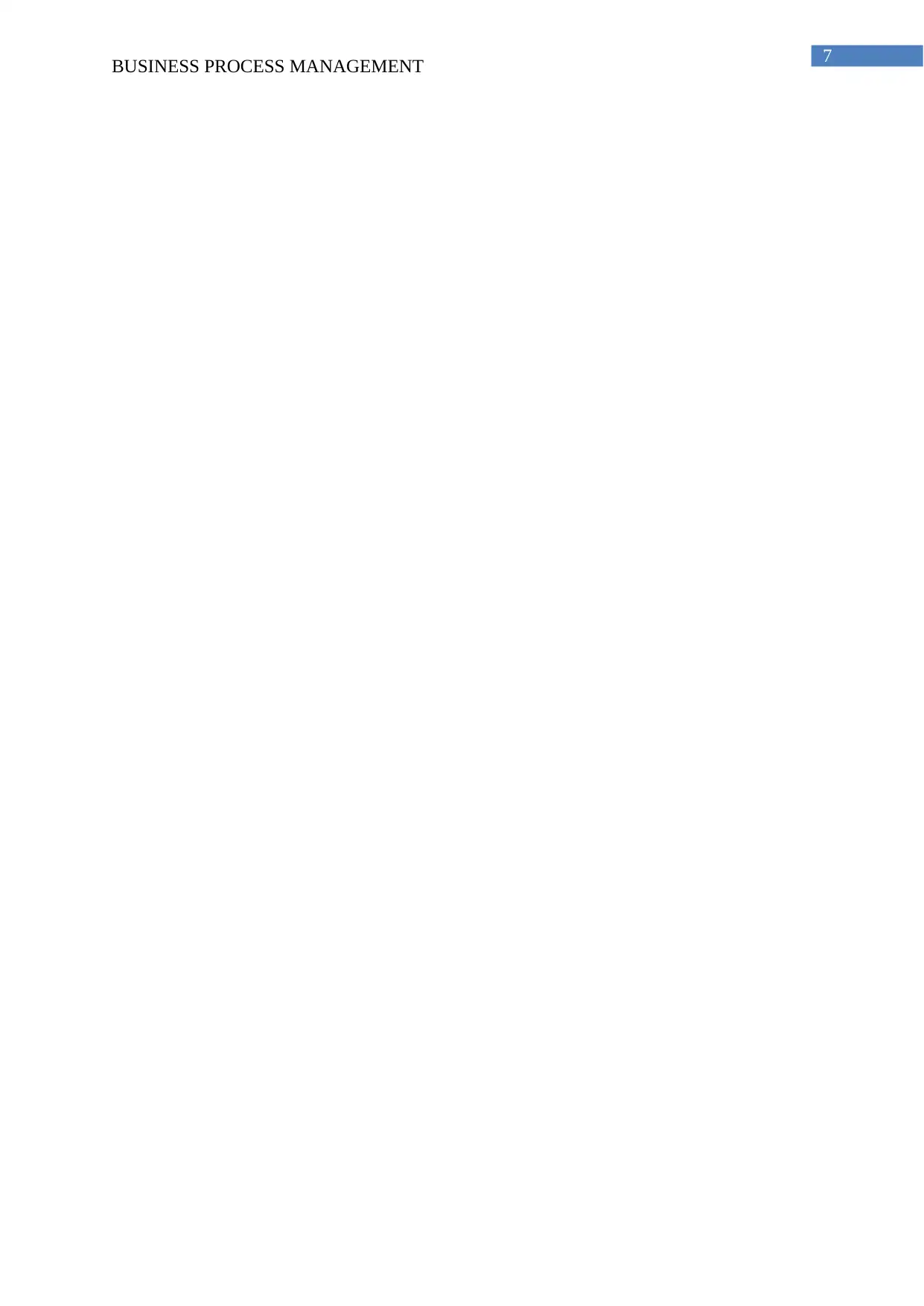
7
BUSINESS PROCESS MANAGEMENT
BUSINESS PROCESS MANAGEMENT

8
BUSINESS PROCESS MANAGEMENT
References
Bai, C. and Sarkis, J., 2013. A grey-based DEMATEL model for evaluating business process
management critical success factors. International Journal of Production Economics, 146(1),
pp.281-292.
Becker, J., Kugeler, M. and Rosemann, M. eds., 2013. Process management: a guide for the
design of business processes. Springer Science & Business Media.
Chang, J.F., 2016. Business process management systems: strategy and implementation.
Auerbach Publications.
De Giacomo, G., De Masellis, R., Grasso, M., Maggi, F.M. and Montali, M., 2014,
September. Monitoring business metaconstraints based on LTL and LDL for finite traces.
In International Conference on Business Process Management(pp. 1-17). Springer, Cham.
Debois, S., Hildebrandt, T. and Slaats, T., 2014, September. Hierarchical declarative
modelling with refinement and sub-processes. In International Conference on Business
Process Management (pp. 18-33). Springer, Cham.
Di Ciccio, C., Maggi, F.M. and Mendling, J., 2014, September. Discovering target-branched
declare constraints. In International Conference on Business Process Management(pp. 34-
50). Springer, Cham.
Dumas, M., La Rosa, M., Mendling, J. and Reijers, H.A., 2013. Fundamentals of business
process management (Vol. 1, p. 2). Heidelberg: Springer.
Hammer, M., 2015. What is business process management?. In Handbook on business
process management 1 (pp. 3-16). Springer, Berlin, Heidelberg.
Jeston, J., 2014. Business process management. Routledge.
Mendling, J., Weber, I., Aalst, W.V.D., Brocke, J.V., Cabanillas, C., Daniel, F., Debois, S.,
Ciccio, C.D., Dumas, M., Dustdar, S. and Gal, A., 2018. Blockchains for business process
management-challenges and opportunities. ACM Transactions on Management Information
Systems (TMIS), 9(1), p.4.
Noe, R.A., Hollenbeck, J.R., Gerhart, B. and Wright, P.M., 2017. Human resource
management: Gaining a competitive advantage. New York, NY: McGraw-Hill Education.
BUSINESS PROCESS MANAGEMENT
References
Bai, C. and Sarkis, J., 2013. A grey-based DEMATEL model for evaluating business process
management critical success factors. International Journal of Production Economics, 146(1),
pp.281-292.
Becker, J., Kugeler, M. and Rosemann, M. eds., 2013. Process management: a guide for the
design of business processes. Springer Science & Business Media.
Chang, J.F., 2016. Business process management systems: strategy and implementation.
Auerbach Publications.
De Giacomo, G., De Masellis, R., Grasso, M., Maggi, F.M. and Montali, M., 2014,
September. Monitoring business metaconstraints based on LTL and LDL for finite traces.
In International Conference on Business Process Management(pp. 1-17). Springer, Cham.
Debois, S., Hildebrandt, T. and Slaats, T., 2014, September. Hierarchical declarative
modelling with refinement and sub-processes. In International Conference on Business
Process Management (pp. 18-33). Springer, Cham.
Di Ciccio, C., Maggi, F.M. and Mendling, J., 2014, September. Discovering target-branched
declare constraints. In International Conference on Business Process Management(pp. 34-
50). Springer, Cham.
Dumas, M., La Rosa, M., Mendling, J. and Reijers, H.A., 2013. Fundamentals of business
process management (Vol. 1, p. 2). Heidelberg: Springer.
Hammer, M., 2015. What is business process management?. In Handbook on business
process management 1 (pp. 3-16). Springer, Berlin, Heidelberg.
Jeston, J., 2014. Business process management. Routledge.
Mendling, J., Weber, I., Aalst, W.V.D., Brocke, J.V., Cabanillas, C., Daniel, F., Debois, S.,
Ciccio, C.D., Dumas, M., Dustdar, S. and Gal, A., 2018. Blockchains for business process
management-challenges and opportunities. ACM Transactions on Management Information
Systems (TMIS), 9(1), p.4.
Noe, R.A., Hollenbeck, J.R., Gerhart, B. and Wright, P.M., 2017. Human resource
management: Gaining a competitive advantage. New York, NY: McGraw-Hill Education.
⊘ This is a preview!⊘
Do you want full access?
Subscribe today to unlock all pages.

Trusted by 1+ million students worldwide
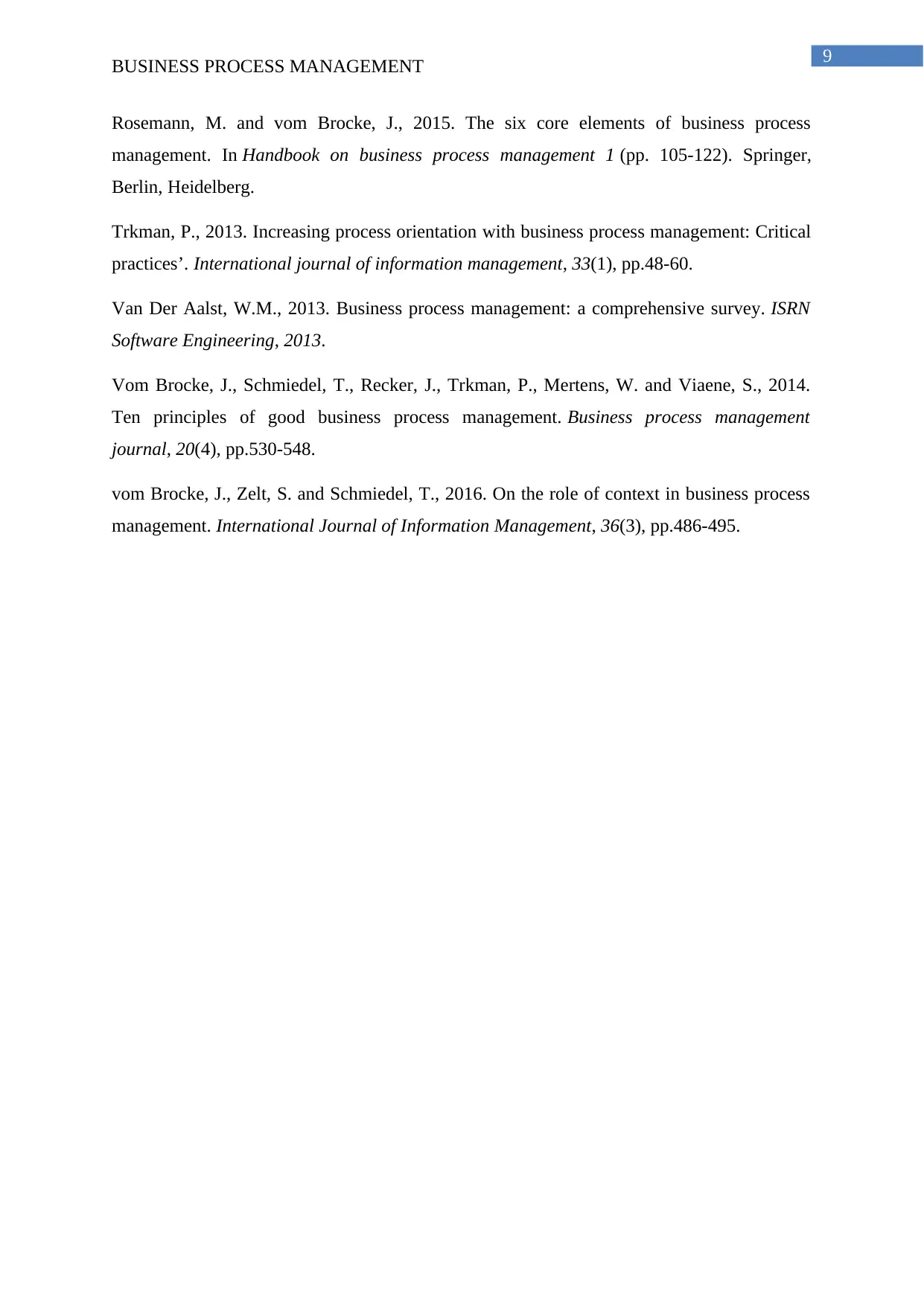
9
BUSINESS PROCESS MANAGEMENT
Rosemann, M. and vom Brocke, J., 2015. The six core elements of business process
management. In Handbook on business process management 1 (pp. 105-122). Springer,
Berlin, Heidelberg.
Trkman, P., 2013. Increasing process orientation with business process management: Critical
practices’. International journal of information management, 33(1), pp.48-60.
Van Der Aalst, W.M., 2013. Business process management: a comprehensive survey. ISRN
Software Engineering, 2013.
Vom Brocke, J., Schmiedel, T., Recker, J., Trkman, P., Mertens, W. and Viaene, S., 2014.
Ten principles of good business process management. Business process management
journal, 20(4), pp.530-548.
vom Brocke, J., Zelt, S. and Schmiedel, T., 2016. On the role of context in business process
management. International Journal of Information Management, 36(3), pp.486-495.
BUSINESS PROCESS MANAGEMENT
Rosemann, M. and vom Brocke, J., 2015. The six core elements of business process
management. In Handbook on business process management 1 (pp. 105-122). Springer,
Berlin, Heidelberg.
Trkman, P., 2013. Increasing process orientation with business process management: Critical
practices’. International journal of information management, 33(1), pp.48-60.
Van Der Aalst, W.M., 2013. Business process management: a comprehensive survey. ISRN
Software Engineering, 2013.
Vom Brocke, J., Schmiedel, T., Recker, J., Trkman, P., Mertens, W. and Viaene, S., 2014.
Ten principles of good business process management. Business process management
journal, 20(4), pp.530-548.
vom Brocke, J., Zelt, S. and Schmiedel, T., 2016. On the role of context in business process
management. International Journal of Information Management, 36(3), pp.486-495.
1 out of 10
Your All-in-One AI-Powered Toolkit for Academic Success.
+13062052269
info@desklib.com
Available 24*7 on WhatsApp / Email
![[object Object]](/_next/static/media/star-bottom.7253800d.svg)
Unlock your academic potential
Copyright © 2020–2025 A2Z Services. All Rights Reserved. Developed and managed by ZUCOL.
